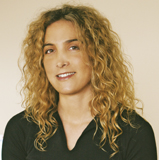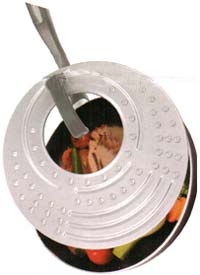 |
|
Written by ZOOZ
consulting and training | (972)-9-9585085 | [email protected]
| www.zooz.co.il
|
| Issue 32 |
Hello!
We
are pleased
to send you the new issue of LaZOOZ.
This monthly newsletter is sent as a free
service to thousands of senior executives.
It features different sections each time, and does not include advertisements.
We tried to keep it brief, assuming that your time is precious
and the work is plentiful.
Those who wish to learn more, will find links to articles and relevant information sources.
We hope that you will find the newsletter useful. We will be happy to receive any comments and suggestions.
Pleasant reading!
Ari Manor, CEO, ZOOZ
|
|
Details
An interview with a senior executive
|
Sigal Projensky, CEO of Studio C
-
Number of company
employees
:
450.
-
Number of direct
subordinates
: 10.
- We provide: Body toning, sculpting and weight loss for women.
-
I have been in my
position for
: for two and a half years. Prior to that I was VP of Marketing & Sales at Studio C. In the past I was Marketing Manager of Mey Eden Bar for four and a half years, and before that I worked at Coca Cola for six years (Marketing Coordinator, Planner, and finally MarCom Manager). I have a B.A. in Business Administration from the College of Management, and an M.B.A. from the Israeli extension of The University of Manchester.
-
What I like about the
job
: The challenge – to turn Studio C into a booming and developing business. I am given free reign and independence in my position, which allows me to initiate innovative strategic and marketing steps. I enjoy the management challenge – managing people, developing new products and services, and opening more branches around the country. It’s fun to concoct ventures and ideas and set them free for implementation.
-
The most difficult
part of the job
: That processes take a long time – from conceptualizing the idea to the stage where customers get to enjoy them. Negotiations over a property where we want to open a branch can take a year and then fall through… implementing a new class, for example bone-strengthening exercise for seniors, can take many long months, including developing training programs, training instructors, marketing, etc….
-
Goals I want to
attain
: In my position – to double the turnover by increasing profitability and the number of branches in the chain. I want to exceed 50 branches within two years time (there are currently 34). In my personal life – I dream of having more time for myself and my children.
- Our vision: That Studio C will be the ultimate choice for every woman choosing a healthy lifestyle. We aspire that Studio C will be a home for women of all ages and stages of life. We arrived at this vision through an internal process, after discussions with the staff.
-
An original product
in the market
: During the last two years we expanded our range of unique products, in order to support the strategy and give a satisfactory solution to different target populations. Among the rest: low-impact aerobics for 9-11 year old girls; target training for 13-18 year old girls (improves posture, flexibility, physical fitness, cardiovascular endurance, and combines dance steps); exercise for pregnant women (an especially popular class that prepares the body for childbirth); get-your-body-back-in-shape class, which helps the body bounce back after pregnancy and childbirth (we provide a babysitting service for the new moms participating in this class); and as previously mentioned – also the bone strengthening exercise class for seniors. Moreover, we also added a sweat-free toning and sculpting class to our basic product – a toning and sculpting class where you work out aerobically and burn more calories, and of course…sweat.
-
Sources of
innovation
: We are exposed to needs and problems that exist in Israel and around the world, and we develop appropriate solutions. For example – due to the worldwide epidemic of overweight children and teens, we developed workshops to teach good eating habits to these age groups. Additional ideas are raised in our internal forum called “The CEO Café”, where each time I meet with six different branch managers as well as with dieticians and instructors. During these meetings we discuss problems and needs that arise, which is how we developed a six-meeting workshop that teaches how to manage the family’s eating habits in a healthier and more correct manner. Belly dancing, women’s yoga, kickboxing classes, and more – all originated from these “CEO Café” meetings.
-
Recommended
professional book
:
Good to Great: Why Some Companies Make the Leap . . . and Others Don’t by Jim Collins. Extremely important, like the book says, is to “get the right people on the bus” – because what determines the success of an organization is first and foremost the quality of these people, especially in a service-oriented organization like Studio C.
-
Send feedback to
[email protected]
- Would you like to be interviewed?: contact us
-
Information about Excellence in Customer Service workshops is available
here
(Page 25 in PDF Booklet).
|
|
|
Education
A must-read book for managers
|
State of the World 2007: An Urban Planet / Linda Starke, The Worldwatch
Institute / Bavel Publishers
Published in The Marker
Magazine, April 2007, in "
The
Management Bookworm
" column written by Ari Manor, CEO of ZOOZ.
This bookworm likes finding management books in unusual places as well. This time it surprisingly found a very useful book in a Tower Records store. The book “State of the World 2007” is an annual report published by The Worldwatch Institute, a leader in environmental analyses. The book provides an annual current state of affairs on the health of Planet Earth, and all the chapters contain in-depth discussions of the current global environmental problems.
The opening chapter is especially fascinating, and deals with the reasons for the precipitous increase in overall global consumption, along with the growing imbalance that it creates on the planet. This imbalance creates constantly increasing disparities between the “consumer populations”, with a per capita income of $20 a day or more, and which accounts for approx. a quarter of the world population, and the poor population – which accounts for approx. 40% of the world’s population – and earn less than $2 a day per capita (which according to the UN is the minimum required to fulfill basic needs). The book was written by economists, and focuses on macro-economic trends, but its power comes mainly from the micro level, in the concrete examples that the book provides. For example, if consumers in Europe were to give up ice cream, it would be possible to provide clean water to all as well as immunize all of the world’s children; and if the consumer population were to give up on pet food, it would be possible to eliminate world hunger and malnutrition.
This book is ostensibly intended for the bleeding heart liberals from California or Denmark, interested in obtaining a comprehensive picture of the steps required to slow consumption in order to ensure a long-lasting world (that will support life for generations to come). However, cynical businesspeople can also find this book very interesting. First of all, businesses interested in making money from “green” industries and ecological products can find ideas for potentially very lucrative ventures in the book. Secondly, if “green” ventures leave you cynical, and you are interested in reaping immediate rewards from other fields, you can focus only on the detailed descriptions about worldwide consumer trends. True, the book was not written with this purpose in mind, but it is definitely possible to gain an understanding from the book about countries with anticipated near-future growth, and what types of non-ecological products are clearly in rising demand.
Other chapters in the book focus on energy, water, and food consumption, among other things. The end of each chapter contains a concrete survey of consumption habits and the effects of specific products – plastic bags, computers, water bottles, and more. For example, approx. 14 billion water bottles were sold in the United States in 2002, and although the majority was made from recyclable PET, 90% was thrown to the garbage. The later chapters propose ways to slow consumption and its harmful effects, and provide examples of places that succeeded in doing this. And if you are skeptical about it, the second part of the book will only shed light on your background. This part maps consumption in Israel, and is very relevant for businesses whose customers are mainly Israeli. The bookworm discovered an entire world of knowledge and insight in this book, and also recommends looking for management books in record shops!.
|
|
|
Invention
An innovation which
surprised the world market and competitors
|
A Lid for Every Pot
Surprising innovation can happen to simple, utilitarian, and relatively inexpensive products as well. This is an example of a universal lid that fits all the 20-30 cm diameter pots and pans. The product is sold for 40 NIS at ACE, and is manufactured by the Italian manufacturer, Betha Italia.
This is a lid that can save a lot of space in your kitchen cupboard, and replace up to 7 lids in this diameter range, since it is divided into expanding rings, each perfectly suited to a different sized pot or pan. The lid is made from stainless steel, and also incorporates a glass window for viewing the cooking in progress. In addition – the lid contains tiny ventilation and steaming holes, and a comfortable and ergonomic handle. The lid can also be used for oven roasting and can be washed in the dishwasher.
It is interesting to note that the innovations found in the lid cover a wide range of inventive thinking tools described in previous issues of this newsletter:
multiplication and
distribution (distribution to 7 different sized rings);
adjustment to the environment (to steam, the hand and eye, the oven and dishwasher); partial
reduction (glass window and steam holes);
adding a dimension (eliminating the relationship between the size of the lid and the size of the pot/pan).
The scope of sales from this lid will apparently not be very large, since it is a single product (and not part of a product line), and it not supported by a well-known brand, with considerable advertising budgets, or through diverse distribution channels. Also, extremely practical innovation does not always create a large market. However, in this case, it can at least create more space for you in your cupboard… .
-
For information on
Systematic Innovation workshops:
see here or
contact us
-
An article on the Six Inventive Thinking Tools
can be found
here
.
|
|
|



